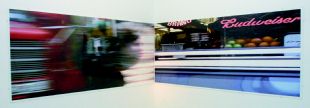
Numbing documentation
Solange Fabião: Transition NYC-Tornio. The Aine Art Museum Jan 17th — Feb 23rd 2003.
Video art, video installation landed Finland twenty years ago. The ground breaker was Marikki Hakola, who believes that video art is meant to lash out the power of media, contradict their verity and break their picture of the world. The other task is to conquer the fear of technology. "Art Polaris, Art Stars in Lapland" is a northern art museums' collaborative project, of which the video installation in Aine Art Museum is part. It’s been previously shown in Mexico City and New York. The artist, Brazilian born Solange Fabião recites the "it’s part of more extensive project called TRANSITIO (global dialogue, that embodies a city within a city)". The previous exhibition locations have been big cities, and instead Tornio is a small country town. What does a video from the streets of New York transmit to the citizens of small northern town? For many the images from Bronx to Manhattan have been transmitted through media, but at the opening there were people, who have visited New York 10-12 times. An oblong shaped strained big white screen functioned as a sculptural element. There are no chairs in the assembly hall, so the viewer must stand through the 1 hour 3 minute piece. The exhibition is developed of 17,3 mile (approx. 30 km) trip, which is filmed from the back seat window of a taxi. The jolting of a car and the limited view from the window, more or less swarming metropolitan has been captured as images and noise on the tape. One purpose of the installation is estranging and in it the piece succeeds. Neon lights, traffic, garbage, advertisements, sidewalks, streets, parks, houses, fences and people bump along in a fast pace. The clatter, rattling, buzz, horns and screams accompany the visual image. Images and noise reach ones ears and eyes, but the brains stop reacting. The artist has aimed for objectivity. Few zooms and camera movements however reveal the artist’s interest for the objects: a bread, beautiful face, Empire State Building and Broadway 2231. Video transmits a lot of information that is meaningless for human life. This kind of visual stuff makes the viewer gradually numb, so that the receiving important data can be prevented. I wonder if this piece is a mirror that reflects modern man's self-centered, or middle and upper class typed approach in the society today? The same kind of shattered view one can get at doctor’s office, where the talk is about a shoulder, a kidney or a heart, instead of the whole person. In video art the time is an essential factor. There is a conflict between over one hour-long performance and few second scenes. For the public the media language is familiar from TV and movies. This exhibition doesn't make you want go deep into the entity and message of video art. This piece addresses the idea of itself, which no one (?) has ever actualized despite of its easiness. There is a lot of aesthetics in this piece. When the images rush through, one has time to think about the life behind the images. What really happened in New York during that hour? The end of the film slows the image and absorbs the noise. For some it can also be a relief, because this piece is not for those who suffer from migraine!
Image above: Solange Fabião has captured on video 17,3 miles of views of New York. The piece is part of Art Polaris.
Image in the middle: Person entering the space first meets a great big X. Part of the video show is reflected through the slits..
Pohjolan Sanomat Jan 29th 2003, Marja-Leena Hyvärinen